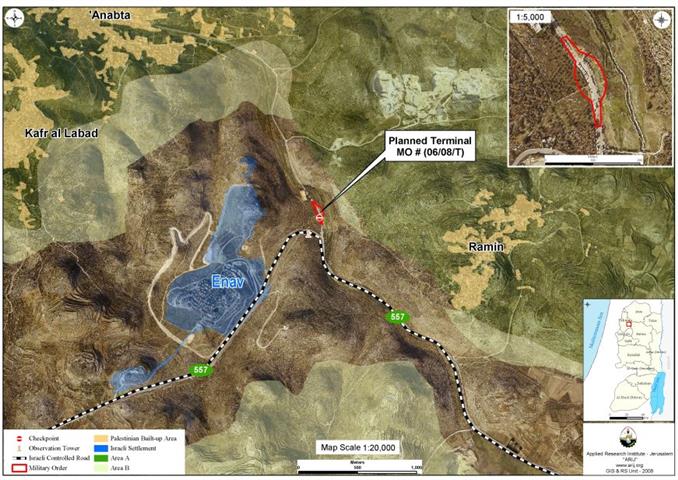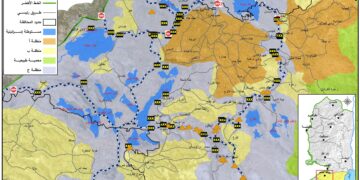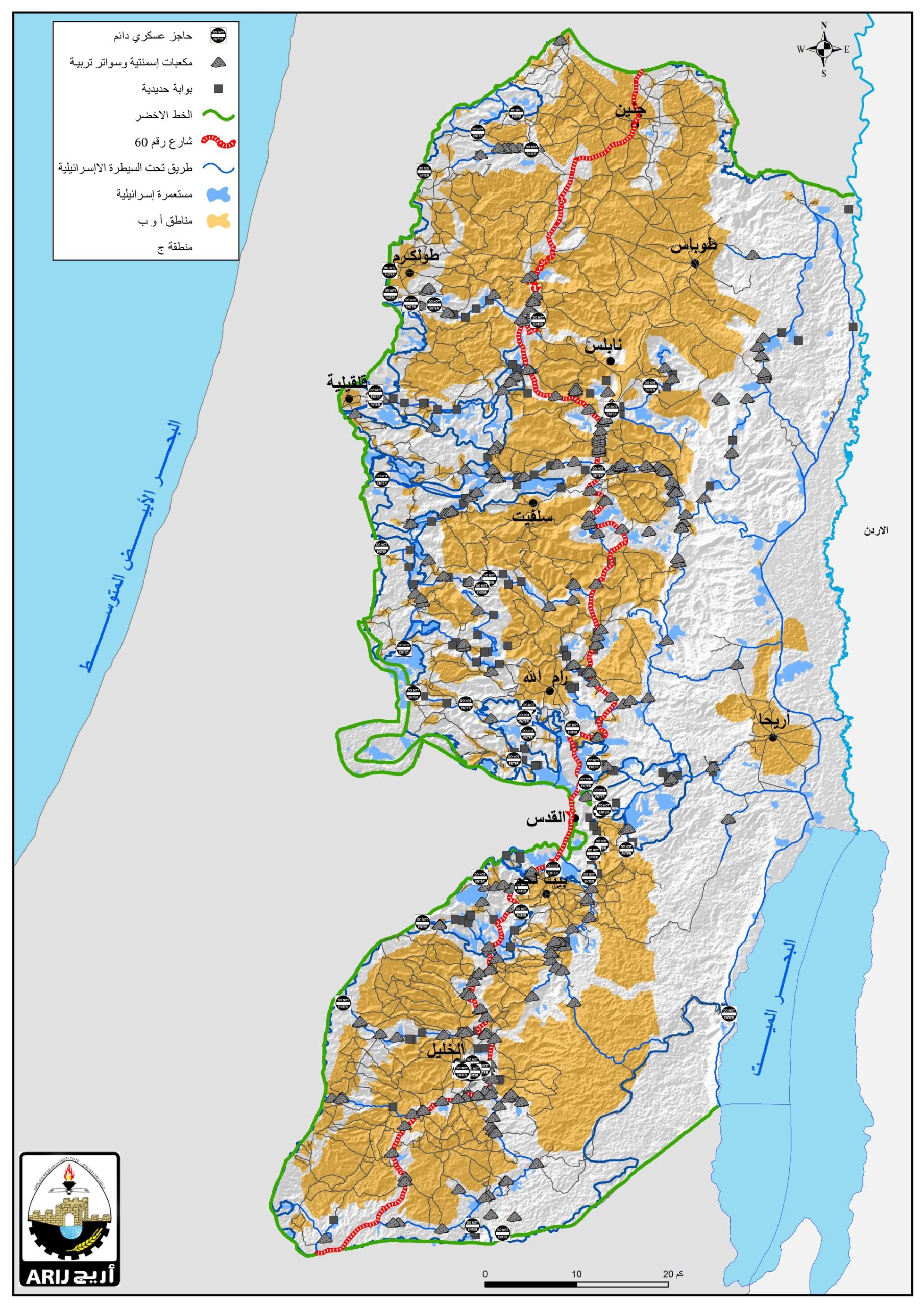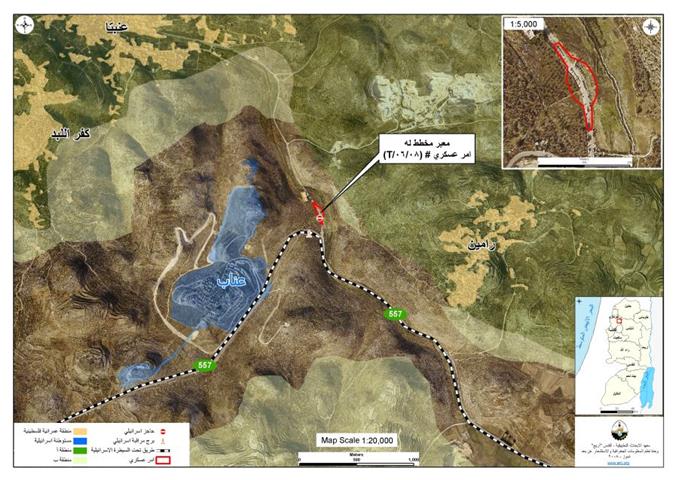On the 11 of August 2008, the Israeli military Authorities decided to confiscate 6.5 dunums of lands of Ramin village for the use of military purposes, mainly to expand Enav military checkpoint located to the west of the village. The decision came after the IO authorities issued a military order number (06/08/T) stipulating the confiscation of lands for that purpose. See Map 1) stipulating the confiscation of lands for that purpose.
Following the eruption of the second Intifada in September 2000, the Israeli Occupation forces erected Enav checkpoint at the junction that separates Ramin village from Enav settlement, known today as 'Enav Junction'. The checkpoint is known to be one of the main passages for trade and civilian transportation to and from Tulkarem Governorate. Israeli Soldiers manning Enav checkpoint conduct thorough inspection procedures, and continue to impose a state of closure, including restrictions on trade and travel.
Ramin Village: Location and Population:-
Ramin, a Palestinian village located in the northeastern part of the west bank, about 15 kilometers east of Tulkarm city. The village's total are is 8934 dunums, out of which, 269 dunums are occupied by the built-up area which totals about 2,200 inhabitants (PCPS 2006).
Land Classification of Ramin Village
In the Oslo II Interim Agreement that was signed in September 1995 between the Palestinian National Authority and Israel, the Palestinian areas were categorized into three areas (A, B and C) which aimed at a phased withdrawal of the Israeli military forces from these areas until the accomplishment of a final status agreement.
-
Area (A) constitutes the areas where Palestinians have complete autonomy over administrative and security issues and covered the main cities of the West Bank, except for Hebron.
-
Area (B), Palestinians have full control over the civil responsibilities and Israel continues to have overriding responsibility for security;
-
Area (C): Palestinians have responsibility for civil life such as economics, health and education; however, Israel retains full control over security and administration related to territory.
Accordingly, the sum of 3654.4 dunums of land (41%) of the total land area of Ramin village were classified as area 'A', leaving 505.6 Dunums, 6% of the total area classified as area 'B', and 4774 Dunums (51%) of the total area of the village area as Area 'C'.
The Israeli Colonization Activities in Ramin Village
To the west of the village, lies the Israeli settlement (Enav) which was established back in 1981. Today, the settlement occupies a total land area of 682 Dunums of Ramin's village lands and houses a population of 550 Israeli settlers.
For the purposes of connecting the settlement of Enav with the nearby Israeli settlements located to its west and east of the village, ('Avnei Hefetz' and Shavei Shomron), the Israeli Occupation Authorities constructed bypass road No. (557) which came on another portion of the village's land.
To Conclude :-
The Israeli restrictions imposed on Palestinians' movement within the territory they live in affects the exercise of their basic human rights; their right to work, the right to health, the right to an adequate standard of living, the right to protection of family life and the right to education, all set in the International Covenant on Economic, Social and Cultural Rights.
-
Article 6: The States Parties to the present Covenant recognize the right to work, which includes the right of everyone to the opportunity to gain his living by work which he freely chooses or accepts, and will take appropriate steps to safeguard this right.'
-
Article 10: The widest possible protection and assistance should be accorded to the family, which is the natural and fundamental group unit of society, particularly for its establishment and while it is responsible for the care and education of dependent children.
-
Article 11: The States Parties to the present Covenant recognize the right of everyone to an adequate standard of living for himself and his family, including adequate food, clothing and housing, and to the continuous improvement of living conditions. The States Parties will take appropriate steps to ensure the realization of this right, recognizing to this effect the essential importance of international co-operation based on free consent.
-
Article 12: The States Parties to the present Covenant recognize the right of everyone to the enjoyment of the highest attainable standard of physical and mental health.
-
Article 13: The States Parties to the present Covenant recognize the right of everyone to education. They agree that education shall be directed to the full development of the human personality and the sense of its dignity, and shall strengthen the respect for human rights and fundamental freedoms.
Article 13 of the Universal Declaration of Human Rights and article 12 of the International Covenant on Civil and Political Rights also entail the right to move freely from one place to another within the state.
Article 12:
1. Everyone lawfully within the territory of a State shall, within that territory, have the right to liberty of movement and freedom to choose his residence.
2. Everyone shall be free to leave any country, including his own.
3. The above-mentioned rights shall not be subject to any restrictions except those which are provided by law, are necessary to protect national security, public order, public health or morals or the rights and freedoms of others, and are consistent with the other rights recognized in the present Covenant.
4. No one shall be arbitrarily deprived of the right to enter his own country.
Article 13:
1. Everyone has the right to freedom of movement and residence within the borders of each State.
2. Everyone has the right to leave any country, including his own, and to return to his country.
Prepared by
The Applied Research Institute – Jerusalem














